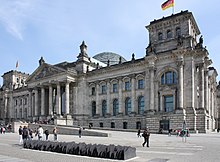Ernst pit
Ernst Grube (born January 22, 1890 in Neundorf (Anhalt) , † April 14, 1945 in Bergen-Belsen ) was a German politician ( KPD ) and resistance fighter against the Nazi regime . From 1920 to 1922 he was a member of the Saxon parliament , from 1924 to 1932 of the Prussian state parliament and in 1924 and from 1930 a member of the Reichstag .
Life
Grube was a carpenter, from 1908 a member and later also a functionary of the German Woodworkers Association and a member of the SPD . At his place of work in a wagon factory in Werdau, Saxony, he was elected chairman of the workers' council by his colleagues in 1918. Ernst Grube had been a member of the local Spartacus group since it was founded, joined the USPD in 1917 and joined the KPD on January 6, 1919. In 1927 he was elected a candidate and in 1929 a member of the Central Committee of the KPD. From 1920 to 1922 he was a member of the Saxon parliament , from 1924 to 1932 of the Prussian state parliament and in 1924 and from 1930 a member of the Reichstag . Since it was founded in 1930, he has headed the “ Combat Association for Red Sports Unit ”.
On February 7, 1933, Grube took part in the illegal meeting of the Central Committee of the KPD in the sports store Ziegenhals near Berlin. Like many other communist members of parliament , on the night of the fire in the Reichstag , on February 27, 1933, the National Socialist terror struck Ernst Grube. His “protection” arrest was followed by a stay of more than six years in various concentration camps: until May 1939 he was imprisoned in Sonnenburg , Lichtenburg and Buchenwald . After his release he worked as a carpenter in Warsaw due to a service obligation . From 1941 Grube was in Berlin, where he maintained connections to the resistance group around Robert Uhrig . Grube was under the surveillance of the Gestapo ; In 1942 he was imprisoned for several months. On August 21, 1944, he was arrested again in the “Grid” campaign, taken to the Sachsenhausen concentration camp and transported to Bergen-Belsen at the beginning of April 1945, where he died of typhus a few days before the end of the war .
Honors
In the GDR , after Ernst Grube, the 10th Border Regiment in Plauen , the children's and youth sports school (KJS) in the Berlin district of Prenzlauer Berg, the Ernst Grube stadiums in Magdeburg and Riesa , the Ernst Grube Hall in Leipzig ( Home of the SC DHfK Leipzig men's handball 2nd Bundesliga and the second match hall of the women's first division handball team HC Leipzig) and in Freiberg / Saxony (home of the upper handball division HSG Freiberg), Ernst-Grube-Strasse in the Berlin district of Spindlersfeld , the Ernst-Grube- Street in Fürstenwalde / Spree , Ernst-Grube-Strasse in Halle (Saale) , Ernst-Grube-Strasse in Meuselwitz , Ernst-Grube-Strasse in Neundorf (Anhalt) and Ernst-Grube-Strasse in Zwickau , the LPG in Vietmannsdorf in Uckermark , the prefabricated housing estate "Ernst Grube" (1987-2016) in Werdau -Sorge, the former Ernst-Grube-Stadion, today's stadium on the ponds, ( Rot-Weiß Werdau ) in Werdau-West and the motor vehicle factory “Ernst Grube “Werdau (Werdau-Süd) named. The latter was the production site for the GDR H6 , G5 and S4000 trucks .
Since 1992 one of the 96 memorial plaques for members of the Reichstag murdered by the National Socialists has been commemorating Grube near the Reichstag in Berlin . A large torpedo speedboat of the People's Navy was named after him in the GDR.
literature
- K. Haferkorn, M. Rutz: Grube, Ernst . In: History of the German labor movement. Biographical Lexicon . Dietz Verlag, Berlin 1970, pp. 174-175.
- Pit, Ernst . In: Hermann Weber , Andreas Herbst : German Communists. Biographisches Handbuch 1918 to 1945. 2nd, revised and greatly expanded edition. Dietz, Berlin 2008, ISBN 978-3-320-02130-6 .
- Achim Arndt: Ernst Grube (1890-1945). In: Siegfried Mielke (ed.): Trade unionists in the concentration camps Oranienburg and Sachsenhausen. Biographical manual. Volume 1, Edition Hentrich, Berlin 2002, ISBN 3-89468-268-X .
Web links
- Literature by and about Ernst Grube in the catalog of the German National Library
- Ernst Grube in the database of members of the Reichstag
- Short biography
Individual evidence
- ^ A b Small encyclopedia of physical culture and sport . Verlag Enzyklopädie Leipzig, Leipzig 1960, p. 596 .
- ↑ Date of death by Martin Schumacher (ed.): MdR Die Reichstag members of the Weimar Republic in the time of National Socialism. Political persecution, emigration and expatriation 1933–1945. Droste-Verlag, Düsseldorf 1991, ISBN 3-7700-5162-9 , p. 247.
- ↑ List of participants
- ↑ Schumacher, MdR , S: 247f.
- ↑ Chemnitzer Verlag und Druck GmbH & Co. KG: The last prefabricated buildings fall. In: Freiepresse.de. Retrieved March 26, 2016 .
| personal data | |
|---|---|
| SURNAME | Pit, Ernst |
| BRIEF DESCRIPTION | German politician (KPD), MdR and resistance fighters against the Nazi regime |
| DATE OF BIRTH | January 22, 1890 |
| PLACE OF BIRTH | Neundorf (Anhalt) |
| DATE OF DEATH | April 14, 1945 |
| Place of death | Bergen-Belsen |

